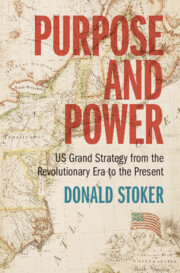Book contents
- Purpose and Power
- Purpose and Power
- Copyright page
- Dedication
- Contents
- Figures
- Maps
- Abbreviations
- Thinking about Grand Strategy in Peace and War
- Part I From Backwater to Great Power
- Part II From Great Power to Superpower
- 7 Stepping upon the Global Stage, 1913–1921
- 8 The Interwar Interlude, 1921–1939
- 9 Moving Astride the World: The Second World War, 1939–1945
- 10 The Hot Peace and the Korean War, 1945–1953
- 11 The Hot Peace: The Eisenhower, Kennedy, And Johnson Years, 1953–1969
- 12 The Vietnam War, 1961–1969
- 13 Détente and Defeat: Nixon, Ford, and Vietnam, 1969–1977
- 14 For Want of a Vision: The Carter Years, 1977–1981
- 15 Winning the Hot Peace: Reagan’s Great-Power Competition, 1981–1990
- Part III The Post–Cold War World
- Part IV Retreat and Defeat
- Acknowledgements
- Notes
- Index
15 - Winning the Hot Peace: Reagan’s Great-Power Competition, 1981–1990
from Part II - From Great Power to Superpower
Published online by Cambridge University Press: 11 January 2024
- Purpose and Power
- Purpose and Power
- Copyright page
- Dedication
- Contents
- Figures
- Maps
- Abbreviations
- Thinking about Grand Strategy in Peace and War
- Part I From Backwater to Great Power
- Part II From Great Power to Superpower
- 7 Stepping upon the Global Stage, 1913–1921
- 8 The Interwar Interlude, 1921–1939
- 9 Moving Astride the World: The Second World War, 1939–1945
- 10 The Hot Peace and the Korean War, 1945–1953
- 11 The Hot Peace: The Eisenhower, Kennedy, And Johnson Years, 1953–1969
- 12 The Vietnam War, 1961–1969
- 13 Détente and Defeat: Nixon, Ford, and Vietnam, 1969–1977
- 14 For Want of a Vision: The Carter Years, 1977–1981
- 15 Winning the Hot Peace: Reagan’s Great-Power Competition, 1981–1990
- Part III The Post–Cold War World
- Part IV Retreat and Defeat
- Acknowledgements
- Notes
- Index
Summary
Ronald Reagan decided he would win the Cold War against the Soviet Union. This required a strong economy. He supported the Federal Reserve breaking inflation with high interest rates. He also reduced taxes and regulation. After a short recession, the economy boomed. Reagan harnessed all elements of national power in pursuit of democracy and freedom abroad. Military strength was key, and he launched a massive rearmament program. He pushed human rights issues, pointed out Soviet abuses and hypocrisy, separated the Eastern Bloc from Western money and technology, blocked Soviet advances in the Third World, and used insurgencies against Soviet clients as Moscow did against the West. But Reagan also feared a nuclear exchange and was eager to negotiate reductions in nuclear weapons. He benefitted from Soviet economic weakness, political bankruptcy, and the rise of Mikhail Gorbachev, who realized the Soviet Union needed reduced tensions with the West in order to reform its broken system. George H. W. Bush succeeded Reagan, continued his grand strategy, and reaped the benefit of victory in the Cold War with the collapse of the Soviet Union and the spread of democracy to Eastern and Central Europe, as well as other areas, particularly Latin America.
Keywords
- Type
- Chapter
- Information
- Purpose and PowerUS Grand Strategy from the Revolutionary Era to the Present, pp. 497 - 534Publisher: Cambridge University PressPrint publication year: 2024



